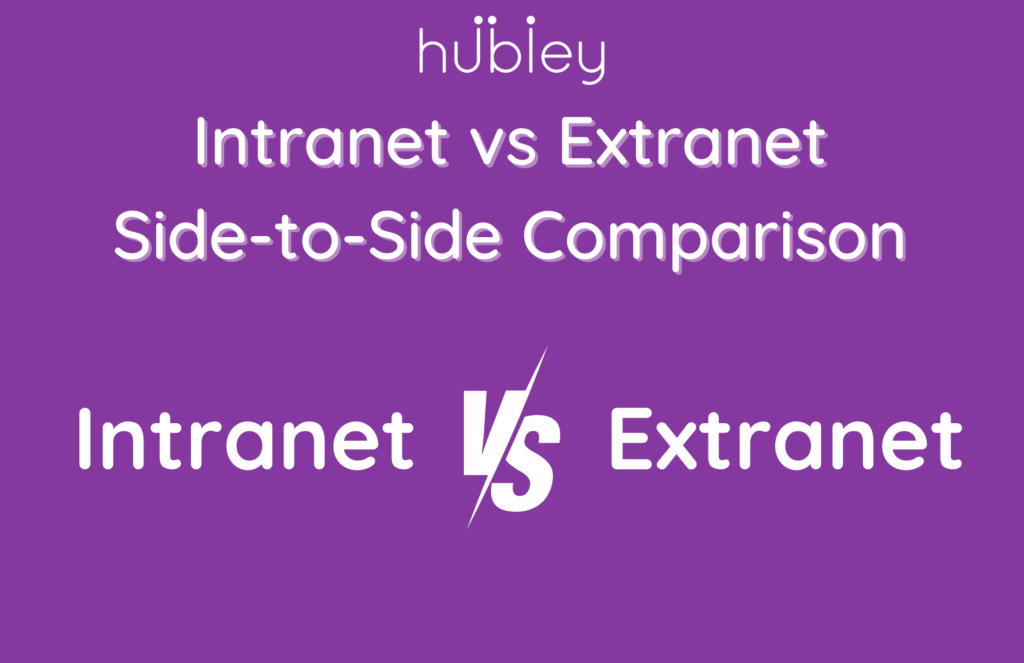All businesses thrive on information, communication, and collaboration, and most use a network of some sort to accomplish these tasks. However, your ideal type of network, whether intranet or extranet, will vary depending on whom your company is communicating with and the nature of the information being shared.
If you’re wondering about which type of network will best suit your business needs, read on. This guide explains the difference between an intranet and an extranet and how to choose the solution that’s right for you.
Defining Intranet and Extranet
An intranet and an extranet are both types of networks. However, each serves a different purpose in your business.
A Closer Look at Intranet: Features and Functionalities
The Internet is a network that gives people and systems around the world the ability to connect and communicate. Conversely, an intranet separates itself from the outside world. It acts as a private local network that allows members of an organization to communicate, store files, and organize tasks and projects.
Demystifying Extranet: Applications and Advantages
An extranet is similar to an intranet in that it is also a private network. However, it allows outside users such as customers, vendors, and business partners to have controlled access to certain parts of that network. This enables them to communicate and access authorized information and files without needing access to the entire internal network.
Key Distinctions Between Intranet and Extranet
When it comes to working with and sharing information on intranets and extranets, it’s important to understand the distinctions between each. Knowing the differences in purpose for an extranet vs. intranet and conducting yourself accordingly will keep your business safe and operating smoothly.
Access Control: Internal vs. External Users
On an intranet, only employees and authorized members of the organization have access to the network and the information contained therein. With an extranet, third parties can access information. External access is granted in a controlled manner with limited capabilities.
Scope of Accessibility: Limited vs. Wider Audience
Intranets cater to a very limited audience: only employees can access them. Thus, the information they share will be relevant to that audience. As such, they might include communications such as:
- Company-wide announcements
- Social networking
- Paperwork signatures
- Policy documentation
- Project timelines
In contrast, extranets have a wider audience that extends to suppliers and partners. Files and information are limited to only what those parties need, such as access to messaging capabilities, order statuses, or shared project files.
Collaborative Capabilities: Team-Oriented vs. Multi-Organizational
Intranets permit collaboration with your organizational team or department, allowing employees to share the files and information they need to get the job done. You may pass sensitive information or casual conversation back and forth.
Extranets, however, facilitate multi-organizational collaboration. You can:
- Upload documents like specifications and proposals
- Assign and manage tasks
- Share real-time updates or data feeds to streamline project completion
Each business entity provides only the necessary information, so there’s no need to wade through irrelevant material.
Security Measures: In-House vs. Extended Network
Intranets are governed by in-house acceptable use policies, while extranets usually require each party to sign an additional agreement about how the information will be accessed and used. As later sections explain, extranets also take a bit of extra work to secure, as you must ensure that third parties are behaving responsibly with sensitive data.
Advantages of an Intranet
There’s no doubt that intranets offer their own unique set of advantages to the enterprise environment. Here’s a rundown of the benefits you can expect to reap in your business.
Streamlining Internal Workflows and Processes
Employees spend 28% of their week managing emails and another 20% tracking down internal information. An intranet provides access to shared calendars, documents, and project management tools that allow them to see who is working, what information they’ve shared, and what still needs to be done.
When HR needs to update policies, schedule training, or get signatures on critical paperwork, an intranet offers easy communication and a seamless process.
Enhancing Knowledge Sharing and Collaboration
An intranet facilitates easy messaging, the building of learning and information hubs, and the creation of a single source of truth for all team members. Documents are updated in real time and can be accessed by all authorized parties simultaneously. This ensures that everyone is working from the most recent data, enhancing efficiency, productivity, and accuracy.
Fostering a Cohesive Company Culture
An intranet is capable of more than messaging, announcements, and document storage. It can also give businesses the ability to provide built-in social networking features for employees.
Intranets give employees a place to publicly recognize colleagues and collect feedback about company-wide initiatives via surveys and polls. In a world where a cohesive culture matters more than ever, an intranet can be an indispensable tool for building that infrastructure.
Advantages of Extranet
An extranet can also be a powerful tool for companies that partner with other organizations to bring products and services to their customers.
Strengthening Business Relationships and Partnerships
Businesses love working with partners who make it easy to get things done. An extranet strengthens business relationships by making crucial information more accessible and communication nearly instantly. In turn, this increases efficiency and productivity for all parties.
Improving Supply Chain Efficiency and Communication
Through an extranet, suppliers can keep track of products and inventory, making it much easier to know when retailers are likely to place a new order. This allows both parties to maintain ideal stock levels and ensure they never run out. If a problem arises, suppliers can get in touch with retailers to craft a solution.
Facilitating Project Collaboration with External Teams
Collaborating with external teams is all about efficient communication and shared information. Extranets don’t just make this possible — they make it easy.
Limitations and Mitigations
When you’re considering the pros and cons of extranet vs. intranet, there are a few potential issues business owners should remain aware of.
Potential Security Risks Associated with Intranet Usage
While an intranet is a private network, employees still have to be careful when using it, especially since it contains sensitive business and customer data. IT teams need to make it clear that unsecured devices should not be used to access the intranet. And company-wide policies should address issues like personal password security and public sharing of private information.
Addressing Scalability Issues in Growing Organizations
As your business grows and you form more partnerships with larger organizations, your data sharing, document storage, and communications needs will also grow. Before you choose an intranet or extranet provider, make sure they can accommodate your future growth by providing flexible solutions and cost-efficient pricing models.
Mitigating Data Privacy Concerns in Extranet Deployments
When dealing with third parties, businesses need to keep data security and compliance requirements in mind. For example, businesses must be vigilant in ensuring that sensitive customer data is only accessed by trusted, authorized individuals. In turn, those individuals must understand the importance of properly handling that data.
Additionally, all IT managers should consider extra security measures. These could include network isolation, encryption, strong authentication, and role-based access controls.
Intranet vs. Extranet: Using Both Solutions for Holistic Networking
While some business owners are still debating investing in an intranet vs. an extranet, it’s important to realize that both carry distinct advantages for your business. You can use an intranet to streamline processes and collaboration, increase productivity, and build a solid company culture. Extranets, by contrast, help you strengthen outside partnerships and improve operational efficiency throughout your organization.
If you’re looking for a place to start building a private network for your business, consider the advantages that hubley provides. You’ll get the benefit of a cost-efficient pricing model and a flexible solution that scales with you as your company grows.
Robust SharePoint apps provide critical functionality for learning, communication, collaboration, and productivity. And software integrations make it possible to ensure seamless communication between internal and external stakeholders.
Contact the hubley team today to schedule a demo or learn more about how we can help you move your company in the right direction by improving internal communication across the board.
FAQs: Answering Common Queries about Intranet and Extranet
What Is the Primary Purpose of an Intranet?
An intranet primarily helps to improve and increase collaboration and productivity by making internal communication more efficient.
Can an Extranet Be Accessed by the General Public?
No. An extranet is a private network owned by one or more organizations and requires credentials for access.
How Does an Intranet Contribute to Employee Engagement?
Intranets drive conversation and knowledge sharing by making it easier for employees to find, talk to, and celebrate each other. Having a shared, cloud-based solution for project management and document sharing also makes collaboration a breeze, further incentivizing employees to remain engaged throughout each project.
What Security Measures Are Essential for an Extranet?
Maintaining extranet security requires IT teams to isolate the extranet from their other networks to avoid exposing sensitive information. IT managers must also implement strong authentication techniques, granular access controls, and air-tight encryption technology.
Is It Possible to Merge Intranet and Extranet Functionalities?
While extranets give outside stakeholders access to critical information while safeguarding the sensitive data contained within an intranet, some functionalities can be merged through the integration of different software platforms like Microsoft 365. It’s best to contact your intranet provider with questions about custom solutions.









